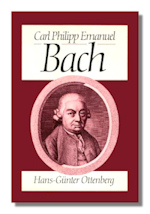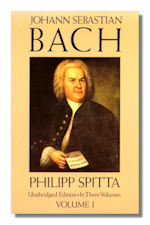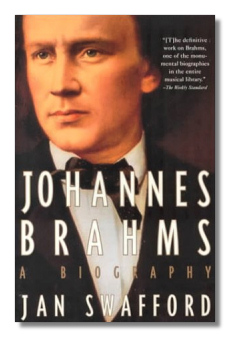Site Search
Follow us on


Affiliates
Books About Music
Biographies

-
C.P.E. Bach. Hans-Günter Ottenberg. Oxford University Press. 1991. ISBN 0193152460 (hardcover), 0198162456 (paperback).
-
The only recent attempt at a complete life-and-works study in book form, this biography provides a wide-ranging survey of Bach's music, including much previously unpublished material. Ottenberg takes special care to set the music firmly within its context – social, intellectual, and aesthetic – and offers a wealth of information about Bach's interactions with noteworthy literary and philosophical figures. A final chapter is devoted to Bach's posthumous influence and reputation.
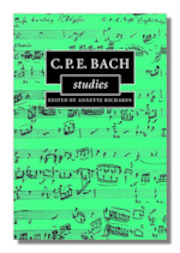
-
C.P.E. Bach Studies. Annette Richards (Editor). Cambridge University Press. 2006. ISBN 0521836298 (hardcover).
-
Focusing on his activity in Hamburg from 1767 until his death in 1788, this collection of essays explores the literary and aesthetic contexts of C.P.E. Bach's later work. It includes essays on Bach's position on contemporary concepts of responsiveness, his sacred music and views on religion, and on the contemporary and posthumous reception of his music. The volume seeks to re-establish the centrality of Bach's music in late 18th-century German culture.
-
The Letters of C.P.E. Bach. C.P.E. Bach (Author), Stephen L. Clark (Translator). Oxford University Press. 1997. ISBN 0198162383 (hardcover).
-
This is a complete edition of the correspondence of the most famous of J.S. Bach's sons. Very few of these letters have appeared previously in English translation. They provide a fascinating picture of an eighteenth-century composer hard at work publishing his own music, debating aesthetic matters, and championing the music and teachings of his father. The readable translation, detailed index, extensive cross referencing, and glossary of names make this an accessible and useful volume.
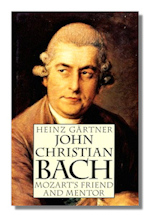
-
John Christian Bach: Mozart's Friend and Mentor. Heinz Gärtner, Reinhard G. Pauly (Translator). Amadeus Press. 1995. ISBN 0931340799 (hardcover).
-
The youngest surviving son of Johann Sebastian Bach, John Christian (born Johann, he adopted the English form of his name in maturity) represents a unique link between the baroque and classical worlds. His early musical training was with his father but his own musical preferences led him to Italy and study with Padre Martini. He abandoned the Lutheranism of his youth, becoming a Roman Catholic and composing much sacred music as organist of Milan Cathedral. He became Mozart's friend and mentor, having met him when the child prodigy visited London in 1764. During his lifetime he was the most successful of the musical Bachs, although he died deeply in debt, and until quite recent years his music has been largely ignored. This impeccably researched biography of the man and his times is evidence that his true stature is now being recognized.
-
John Christian Bach. Charles Sanford Terry. Travis & Emery Music Bookshop. 2009. ISBN 1906857326 (hardcover).
-
Facsimile of 1929 edition.
-
Johann Sebastian Bach: His Work and Influence on the Music of Germany, 1685-1750. Philipp Spitta, Clara Bell, J.A. Fuller-Maitland (Translator). Dover Publications. 1993. ISBN Volume 1
0486274128 (paperback), Volume 2
0486274136 (paperback), Volume 3
0486274144 (paperback).
-
This monumental 3-volume study of Bach is the foundation of all later scholarship. Detailed information on almost everything known about Bach's life and family; also perceptive analyses of all important compositions – over 500 pieces – with more than 450 musical excerpts. Scholarly, yet can be read with profit by any serious music lover.
-
J.S. Bach. by Albert Schweitzer, translated by Ernest Newman. Dover Publications. 1966. ISBN Volume 1
0486216314 (paperback), Volume 2
0486216322 (paperback).
-
Volume One Historical account of Protestant church music before Bach, church music in Germany, the life of Bach, discussion of all of Bach's instrumental music. Musical examples. The second volume of this two volume work, an unabridged republication of the 1911 edition, is concerned with Bach's choral music. Musical examples.
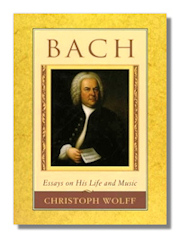
-
Bach: Essays on His Life and Music. Christoph Wolff. Harvard University Press. 1994. ISBN 0674059263 (paperback).
-
Johann Sebastian Bach holds a singular position in the history of music. A uniquely gifted musician, he combined outstanding performing virtuosity with supreme creative powers and remarkable intellectual discipline. More than two centuries after his lifetime, Bach's work continues to set musical standards. The noted Bach scholar Christoph Wolff offers in this book new perspectives on the composer's life and remarkable career. Uncovering important historical evidence, the author demonstrates significant influences on Bach's artistic development and brings fresh insight on his work habits, compositional intent, and the musical traditions that shaped Bach's thought. Wolff reveals a composer devoted to an ambitious and highly individual creative approach, one characterized by constant self-criticism and self-challenge, the absorption of new skills and techniques, and the rethinking of riches from the musical past. Readers will find illuminating analyses of some of Bach's greatest music, including the B Minor Mass, important cantatas, keyboard and chamber compositions, the Musical Offering, and the Art of Fugue. Discussion of how these pieces "work" will be helpful to performers – singers, players, conductors – and to everyone interested in exploring the conceptual and contextual aspects of Bach's music. All readers will find especially interesting those essays in which Wolff elaborates on his celebrated discoveries of previously unknown works: notably the fourteen "Goldberg" canons and a collection of thirty-three chorale preludes. Representing twenty-five years of scholarship, these essays – half of which appear here in English for the first time – have established Christoph Wolff as one of the world's preeminent authorities on J.S. Bach. All students, performers, and lovers of Bach's music will find this an engaging and enlightening book.
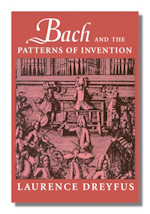
-
Bach and the Patterns of Invention. Laurence Dreyfus. Harvard University Press. 1997. ISBN 0674060059 (hardcover).
-
In this major new interpretation of the music of J.S. Bach, we gain a striking picture of the composer as a unique critic of his age. By reading Bach's music "against the grain" of contemporaries such as Vivaldi and Telemann, Laurence Dreyfus explains how Bach's approach to musical invention in a variety of genres posed a fundamental challenge to Baroque aesthetics. "Invention" – the word Bach and his contemporaries used for the musical idea that is behind or that generates a composition – emerges as an invaluable key in Dreyfus's analysis. Looking at important pieces in a range of genres, including concertos, sonatas, fugues, and vocal works, he focuses on the fascinating construction of the invention, the core musical subject, and then shows how Bach disposes, elaborates, and decorates it in structuring his composition. Bach and the Patterns of Invention brings us fresh understanding of Bach's working methods, and how they differed from those of the other leading composers of his day. We also learn here about Bach's unusual appropriations of French and Italian styles – and about the elevation of various genres far above their conventional status. Challenging the restrictive lenses commonly encountered in both historical musicology and theoretical analysis, Dreyfus provocatively suggests an approach to Bach that understands him as an eighteenth-century thinker and at the same time as a composer whose music continues to speak to us today.
-
J.S. Bach As Organist: His Instruments, Music, and Performance Practices. George Stauffer, Ernest May (Editor). Indiana University Press. 1986. ISBN 0253331811 (hardcover).
-
In J.S. Bach as Organist, specialists from six countries explore Bach's relationship to his favorite instrument during all periods of his career. J.S. Bach as Organist is a book for scholars, performers, and students. Authoritative and wide-ranging.
-
The New Grove Bach Family. Christoph Wollf, et al. W.W. Norton & Company. 1997. ISBN 0393303543 (paperback).
-
An expanded and updated version of the biographical, musical, and bibliographical information found in the New Grove Dictionary of Music & Musicians. Contains biographies and works lists for the following Bach family members (in chronological order): Johann, Johann Christoph, Johann Michael, Johann Nicolaus, Johann Bernard, Johann Ludwig, Johann Sebastian, Wilhelm Friedemann, Carl Philipp, Johan Ernst, Johann Christoph Friedrich, Johann Christian, Johann Michael, and Wilhelm Friedemann Ernst.
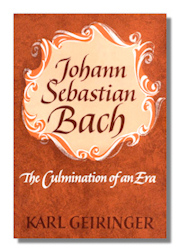
-
Johann Sebastian Bach: the Culmination of an Era. Karl Geiringer. Oxford University Press. 1966. ISBN 0195005546 (hardcover).
-
This basic, one-volume study of Johann Sebastian Bach combines a sensitive biographical sketch with a detailed analysis of each of his major types of composition, including vocal music, organ music, keyboard music, and instrumental music. In each section, Geiringer thoroughly examines many Bach compositions and evaluates them in relation to the rest of the composer's work, as well as in relation to the music of his contemporaries. More than seventy musical examples enable the reader to understand how Bach worked and to observe his music in various stages of completion. In addition, an interesting aspect of research methods is revealed through an explanation of the techniques used in studying handwriting, paper, and watermarks in the original sources.
-
Bach Reader. Hans T. David, Arthur Mendel. W.W. Norton & Company. 1966. ISBN 0393002594 (paperback).
-
-
Basically Bach: A 300th Birthday Celebration. Herbert Kupferberg. McGraw-Hill. 1985. ISBN 0070356467 (paperback).
-
Mili Alexeyevich Balakirev
-
The New Grove Russian Masters, I. David Brown, et al. W.W. Norton & Company. 1997. ISBN 0393315851 (paperback).
-
Comprehensive biographical articles taken from the New Grove Dictionary of Music & Musicians. Included are: Mikhail Glinka, Alexander Borodin, Mili Alexeyevich Balakirev, Modest Musorgsky, and Piotr Ilyich Tchaikovsky
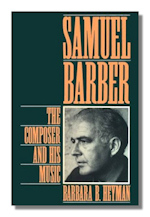
-
Samuel Barber: The Composer and His Music. Barbara B. Heyman. Oxford University Press. 1994. ISBN 0195090586 (paperback).
-
Samuel Barber (1910-1981) was one of the most important and honored American composers of the twentieth century. Writing in a great variety of musical forms – symphonies, concertos, operas, vocal music, chamber music – he infused his works with poetic lyricism and gave tonal language and forms new vitality. His rich legacy includes such famous compositions as the Adagio for Strings, the orchestral song Knoxville: Summer of 1915, three concertos, and his two operas, the Pulitzer Prize-winning Vanessa and Antony and Cleopatra, a commissioned work that opened the new Metropolitan Opera House at Lincoln Center. Generously documented by letters, sketchbooks, original musical manuscripts, and interviews with friends, colleagues and performers with whom he worked, this is the first book to cover Barber's entire career and all of his compositions. The biographical material on Barber is closely interspersed with a discussion of his music, displaying Barber's creative processes at work from his early student compostions to his mature masterpieces. Heyman also provides the social context in which this major composer grew: his education, how he built his career, the evolving musical tastes of American audiences, his relationship to musical giants like Serge Koussevitzky, and the role of radio in the promotion of his music. A testament to the significance of the new Romanticism, Samuel Barber stands as a model biography of an important American musical figure.
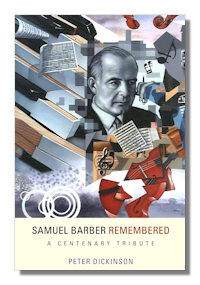
-
Samuel Barber Remembered: A Centenary Tribute. Edited by Peter Dickinson. University of Rochester Press. 2010. ISBN 1580463509 (hardcover).
-
Samuel Barber is one of America's most popular classical composers. His widely beloved works include Adagio for Strings and Knoxville: Summer of 1915. The main source for Samuel Barber Remembered: A Centenary Tribute is a panoply of vivid and eminently readable interviews by Peter Dickinson for a BBC Radio 3 documentary in 1981. The interviewees include Barber's friends, fellow composers, and performers, notably Gian Carlo Menotti, Aaron Copland, William Schuman, Virgil Thomson, soprano Leontyne Price, and pianist John Browning. The book also includes three of the very few interviews extant with Barber himself. Dickinson contributes substantial chapters on Barber's early life and on Barber's reception in England. The book has a foreword by the distinguished composer and admirer of Barber, John Corigliano. Read the Classical Net Review of this book.
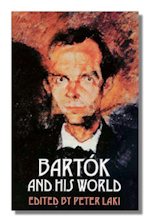
-
Bartók and His World. Peter Laki (Editor). Princeton University Press. 1995. ISBN 0691006334 (paperback).
-
Béla Bartók is one of the most frequently performed twentieth-century composers. He is also the subject of a rapidly growing critical and analytical literature. Bartók was born in Hungary and made his home there for all but his last five years, when he resided in the United States. As a result, many aspects of his life and work have been accessible only to readers of Hungarian. The main goal of this volume is to provide English-speaking audiences with new insights into the life and reception of this musician, especially in Hungary. Part I begins with an essay by Leon Botstein that places Bartók in a large historical and cultural context. László Somfai reports on the catalog of Bartók's works that is currently in progress. Peter Laki shows the extremes of the composer's reception in Hungary, while Tibor Tallián surveys the often mixed reviews from the American years. The essays of Carl Leafstedt and Vera Lampert deal with his librettists Béla Balázs and Melchior Lengyel respectively. David Schneider addresses the artistic relationship between Bartók and Stravinsky. Most of the letters and interviews in Part II concern Bartók's travels and emigration as they reflected on his personal life and artistic evolution. Part III presents early critical assessments of Bartók's work as well as literary and poetic responses to his music and personality.
-
The Life and Music of Béla Bartók. Halsey Stevens, Malcolm Gillies (Editor). Oxford University Press. 1993. ISBN 0195007549/ 0198163495 (paperback).
-
First published in 1953, and again in 1964, Stevens' study is a classic text, combining an authoritative, balanced account of the Hungarian composer's life with candid, insightful analyses of his numerous works, particularly the chamber works. The work now appears in a third edition, prepared by the Bartók scholar Malcolm Gillies. A comprehensive chronological list of works is added, together with a select bibliography and discography. Minor revisions to the text are suggested and a new collection of rare photographs is included.
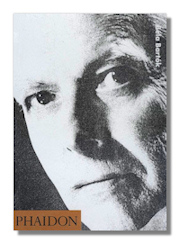
-
Béla Bartók. Kenneth Chalmers. Phaidon Press. 1995. ISBN 0714831646 (paperback).
-
This biography of Béla Bartók includes a contextual study of his work. Illustrated with contemporary photographs of people and events, it show the links between his life, his music and the turbulence of two world wars. Born into the heart of the Austro-Hungarian Empire, Bartók became a fervent nationalist, setting off with his friend Zoltán Kodály to record the folklore of his native Hungary before it was destroyed by the march of progress. He ventured further into Romania and North Africa in pursuit of original cultures. These sounds and experiences helped Bartók find his voice as a composer. Despite his nationalism, his distaste for authoritarian rule brought him into conflict with a crypto-fascist government in Hungary and with the Germany of Adolf Hitler. While composing some of his works, he felt increasingly pressured and in 1940, after the death of his mother, Bartók left Hungary for the United States. Homesick, short of money and stricken with leukaemia, he composed the "Concerto for Orchestra" and, on his deathbed in 1945, was completing a "Third Piano Concerto". This text is part of the 20th-century composers series, examining composers in a biographical context, and offering a comprehensive study of key figures in the creation of 20th-century music. None of the books in the series presume a knowledge of specialized terms or musical notation. Each book in the series features a list of works, a bibliography, and a discography.
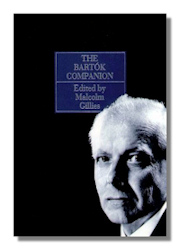
-
Bartók Companion. Malcolm Gilles. Amadeus Press. 1994. ISBN 0931340756 (paperback).
-
Béla Bartók is among the most significant figures in the rise of musical modernism, placed alongside Debussy, Stravinsky, and the composers of the Second Viennese School in the pantheon of the 20th century's most influential innovators. In this specially commissioned collection of essays, the world's leading Bartók specialists, including Benjamin Suchoff, Gyorgy Kroo, Roy Howat, and the composer's son Béla Bartók, Jr., examine every aspect of his musical output and offer insights into his career as a pianist and teacher, tracing the care and concern for order that informed every facet of his work.
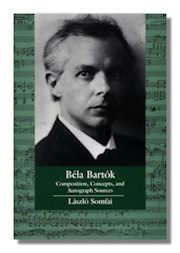
-
Béla Bartók: Composition, Concepts, and Autograph Sources (Ernest Bloch Lectures in Music #9), László Somfai. University of California Press. 1996. ISBN 0520084853 (hardcover).
-
This long-awaited, authoritative account of Bartók's compositional processes stresses the composer's position as one of the masters of Western music history and avoids a purely theoretical approach or one that emphasizes him as an enthusiast for Hungarian folk music. For Béla Bartók, composition often began with improvisation at the piano. László Somfai maintains that Bartók composed without preconceived musical theories and refused to teach composition precisely for this reason. He was not an analytical composer but a musical creator for whom intuition played a central role. These conclusions are the result of Somfai's three decades of work with Bartók's oeuvre; of careful analysis of some 3,600 pages of sketches, drafts, and autograph manuscripts; and of the study of documents reflecting the development of Bartók's compositions. Included as well are corrections preserved only on recordings of Bartók's performances of his own works. Somfai also provides the first comprehensive catalog of every known work of Bartók, published and unpublished, and of all extant draft, sketch, and preparatory material. His book will be basic to all future scholarly work on Bartók and will assist performers in clarifying the problems of Bartók notation. Moreover, it will be a model for future work on other major composers.
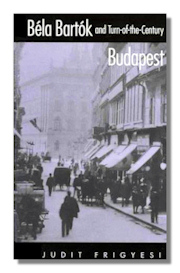
-
Béla Bartók and Turn-Of-The-Century Budapest. Judit Frigyesi. University of California Press. 1998. ISBN 0520207408 (hardcover).
-
Bartók's music is greatly prized by concertgoers, yet we know little about the intellectual milieu that gave rise to his artistry. Bartók is often seen as a lonely genius emerging from a gray background of an "underdeveloped country." Now Judit Frigyesi offers a broader perspective on Bartók's art by grounding it in the social and cultural life of turn-of- the-century Hungary and the intense creativity of its modernist movement. Bartók spent most of his life in Budapest, an exceptional man living in a remarkable milieu. Frigyesi argues that Hungarian modernism in general and Bartók's aesthetic in particular should be understood in terms of a collective search for wholeness in life and art and for a definition of identity in a rapidly changing world. Is it still possible, Bartók's generation of artists asked, to create coherent art in a world that is no longer whole? Bartók and others were preoccupied with this question and developed their aesthetics in response to it. In a discussion of Bartók and of Endre Ady, the most influential Hungarian poet of the time, Frigyesi demonstrates how different branches of art and different personalities responded to the same set of problems, creating oeuvres that appear as reflections of one another. She also examines Bartók's Bluebeard's Castle, exploring philosophical and poetic ideas of Hungarian modernism and linking Bartók's stylistic innovations to these concepts.
-
Béla Bartók. Serge Moreaux, translated by G. S. Fraser and Erik De Mauny. Vienna House. 1974 ISBN 0844301051 (paperback).
-
Chronicles in good style the scholarly folk-song collecting, piano performance, and composing of this twentieth century musical giant.
-
Szekely and Bartók: The Story of a Friendship. Claude Kenneson. Amadeus Press. 1994. ISBN 0931340705 (hardcover).
-
Amy Beach
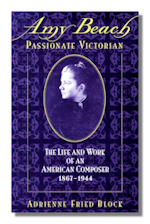
-
Amy Beach, Passionate Victorian: The Life and Works of an American Composer, 1867-1944. Adrienne Fried Block, Fred L. Block. Oxford University Press. 1998. ISBN 0195074084 (hardcover).
-
Amy Marcy Cheney Beach (1867-1944), the most widely performed composer of her generation, was the first American woman to succeed as a creator of large-scale art music. Her "Gaelic" Symphony, given its premiere by the Boston Symphony Orchestra in 1896, was the first work of its kind by an American woman to be performed by an American orchestra. Almost all of her more than 300 works were published soon after they were composed and performed, and today her music is finding new advocates and audiences for its energy, intensity, and sheer beauty. Yet, until now, no full-length critical biography of Beach's life or comprehensive critical overview of her music existed. This biography admirably fills that gap, fully examining the connections between Beach's life and work in light of social currents and dominant ideologies. Adrienne Fried Block has written a biography that takes full account of issues of gender and musical modernism, considering Beach in the contexts of her time and of her composer contemporaries, both male and female. Amy Beach, Passionate Victorian will be of great interest to students and scholars of American music, and to music lovers in general.
-
The Beethoven Sketchbooks: History, Reconstruction, Inventory (California Studies in 19th-Century Music, 4), Douglas Johnson, et al. University of California Press. 1985. ISBN 0520048350 (hardcover).
-
-
Beethoven. William Kinderman. University of California Press. 1995. ISBN 0520087968 (hardcover), 0520212266 (paperback).
-
Combining musical insight with the most recent research, William Kinderman's Beethoven is both a richly drawn portrait of the man and a guide to his music. Kinderman traces the composer's intellectual and musical development from the early works written in Bonn to the Ninth Symphony and the late quartets, looking at compositions from different and original perspectives that show Beethoven's art as a union of sensuous and rational, of expression and structure. In analyses of individual pieces, Kinderman shows that the deepening of Beethoven's musical thought was a continuous process over decades of his life. In this new updated edition, Kinderman gives more attention to the composer's early chamber music, his songs, his opera Fidelio, and to a number of often-neglected works of the composer's later years and fascinating projects left incomplete. A revised view emerges from this of Beethoven's aesthetics and the musical meaning of his works. Rather than the conventional image of a heroic and tormented figure, Kinderman provides a more complex, more fully rounded account of the composer. Although Beethoven's deafness and his other personal crises are addressed, together with this ever-increasing commitment to his art, so too are the lighter aspects of his personality: his humor, his love of puns, his great delight in juxtaposing the exalted and the commonplace.
-
Beethoven: A Critical Biography. Vincent D. Indy. Da Capo Press. 1970. ISBN 0306700190 (hardcover).
-
-
Beethoven in France: The Growth of an Idea. Leo Schrade. Da Capo Press. 1978. ISBN 0306775387 (hardcover).
-
-
Thayer's Life of Beethoven. Elliot Forbes (Editor). Princeton University Press. 1991. ISBN 0691027196 (paperback), 0691027021 (paperback).
-
The huge classic treatment of Beethoven's life and work, originally written by Alexander Wheelock Thayer. The convoluted story of how this work came to be completed is related in the preface.
-
Beethoven: His Life, Work and World. H.C. Robbins Landon, H.C. Robbins Landom. Thames & Hudson. 1993. ISBN 0500015406 (hardcover).
-
-
The Beethoven Compendium: A Guide to Beethoven's Life and Music. Barry Cooper (Editor), et al. Thames & Hudson. 1996. ISBN 0500278717 (paperback).
-
-
Beethoven Letters Journals and Conversations. Michael Hamburger (Editor), Ludwig Van Beethoven. Thames & Hudson. 1992. ISBN 0500273243 (paperback).
-
-
The Letters of Beethoven. Macmillan Publishers. 1985. ISBN 0333398335 (hardcover).
-
Includes virtually all the letters of Beethoven and other relevant documents covering a period of forty years, from 1787 to 1827. The three volumes contain nearly 1,600 fully annotated letters.
-
The New Grove Beethoven (The New Grove), Joseph Kerman, Alan Tyson. W.W. Norton & Company. 1997. ISBN 0393303551 (paperback).
-
-
Beethoven and the Creative Process. Barry Cooper. Oxford University Press. 1992. ISBN 0198163533 (paperback).
-
-
Beethoven and the Creative Process. Oxford University Press. 1992. ISBN 0198161638 (paperback).
-
-
Ludwig Van Beethoven: Approaches to His Music. Carl Dahlhaus, et al. Oxford University Press. 1991. ISBN 0198161484 (hardcover), 0198163991 (paperback).
-
-
Beethoven a Documentary Study. compiled and edited by H.C. Robbins Landon, translated by R. Wadleigh. E. Hartzell. Macmillan. 1974 ISBN 002004500X (paperback).
-
Abridged edition documentary records, letters and other papers written about Beethoven in his lifetime. Well illustrated.
-
Giovanni Bellini. Rona Goffen. Yale University Press. 1989. ISBN 0300043341 (hardcover).
-
-
Giovanni Bellini. Roger Eliot Fry. Ursus Press. 1995. ISBN 1883145031 (hardcover).
-
-
Alban Berg: Master of the Smallest Link. Theodor W. Adorno, Christopher Hailey & Juliane Brand (translators). 1994. Cambridge University Press. ISBN 0521330165 (hardcover), 0521338840 (paperback).
-
This unique study of Austrian composer Alban Berg (1885-1935) is now a part of music history. It is a personal account by Theodor Adorno (1903-1969), a preeminent philosopher and aesthetician, of the life and musical works of his mentor, friend, and composition teacher. In addition to analyses of individual pieces, the book explores the historical and cultural significance of Berg's music, its relationship to that of other nineteenth- and twentieth-century composers, and to the larger issues of contemporary life. This classic study provides a key to understanding Adorno himself as well as offering an individual perspective on one of the major composers of this century.
-
The Music of Alban Berg. Douglas Jarman. University of California Press. 1985. ISBN 0520049543 (paperback).
-
-
Alban Berg The Man and the Work. Mosco Carner. Holmes and Meier. 1988. ISBN 0841908419 (paperback).
-
Thorough discussion and analysis of Berg's compositions. Includes previously unpublished correspondence between Schoenberg and Berg.
-
New Grove Second Viennesse School. Oliver Neighbour, et al. W.W. Norton & Company. 1998. ISBN 0393315878 (paperback).
-
Comprehensive biographical articles taken from the New Grove Dictionary of Music & Musicians. Included are: Alban Berg, Arnold Schoenberg, and Anton Webern.
-
Berio (Oxford Studies of Composers, #20), David Osmond-Smith. Oxford University Press. 1991. ISBN 0193154781 (hardcover).
-
-
Berlioz. D. Kern Holoman. Harvard University Press. 1989. ISBN 0674067789 (hardcover).
-
-
The Memoirs of Hector Berlioz. David Cairns (translator & editor). Victor Gollancz. 1969. ISBN (paperback).
-
Witty and appealing to musician and general reader alike. Highly entertaining and amusing literary side to this great composer.
-
The Memoirs of Hector Berlioz from 1803 to 1865. Ernest Newman (translator & editor). Dover Publications. 1990. ISBN 0486215636 (paperback).
-
Paperback version of this witty composer's delightful memoirs.
-
The New Grove Early Romantic Masters, II. John Warrack, Hugh MacDonald, Karl-Heinz Kohler. W.W. Norton & Company. 1985. ISBN 039330096X (paperback).
-
Comprehensive biographical articles taken from the New Grove Dictionary of Music & Musicians. Included are: Carl Maria von Weber, Hector Berlioz, and Felix Mendelssohn.
-
Five Great French Composers: Hector Berlioz, César Franck, Camille Saint-Saëns, Claude Debussy, Maurice Ravel - Their Lives and Works. Donald Brook. Books for Libraries. 1977. ISBN 0836980794 (hardcover).
-
-
Leonard Bernstein: A Life. Meryle Secrest. Alfred A. Knopf/Vintage Books. 1995. ISBN 0679407316 (hardcover), 067973757X (paperback).
-
-
Leonard Bernstein. Paul Myers. Phaidon Press. 1998. ISBN 0714837016 (paperback).
-
-
Bernstein A Biography. Joan Peyser. Ballantine Books. 1988. ISBN 0345352963 (paperback).
-
An unbuttoned biography of Leonard Bernstein, pianist, composer and conductor with emphasis on his personal life.
-
Georges Bizet, His Life And Works. Douglas C. Parker. Reprint Services. 1926. ISBN 0781290503 (hardcover).
-
-
Georges Bizet. Martin Cooper. Reprint Services. 1938. ISBN 0781294908 (hardcover).
-
-
The New Grove Russian Masters, I. David Brown, et al. W.W. Norton & Company. 1997. ISBN 0393315851 (paperback).
-
Comprehensive biographical articles taken from the New Grove Dictionary of Music & Musicians. Included are: Mikhail Glinka, Alexander Borodin, Mili Alexeyevich Balakirev, Modest Musorgsky, and Piotr Ilyich Tchaikovsky
Nadia Boulanger
-
Nadia Boulanger: A Life in Music. Leonie Rosenstiel. W.W. Norton & Company. 1998. ISBN 0393317137 (paperback).
-
-
Pierre Boulez. Dominique Jameux. Harvard University Press. 1991. ISBN 0674667409 (hardcover).
-
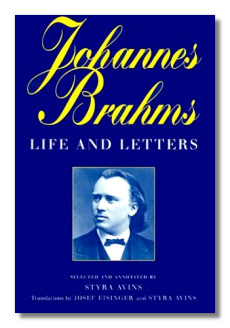
-
Johannes Brahms: Life and Letters. Styra Avins, with Josef Eisinger (co-translator of letters). Oxford University Press. 1997. ISBN 0198162340 (hardcover), 0199247730 (paperback).
-
Considered by many professionals the best and most authoritative Brahms biography in English (see reviews in London Times, NY Times, Financial Times, Wall Street Journal, Music and Letters, New Republic, BBC Music Magazine, Library Review, among many others). An autobiography/biography in correspondence and commentary. This book is the first comprehensive collection of the letters of Johannes Brahms ever to appear in English. Over 550 are included, virtually all uncut, and there are over a dozen published here for the first time in any language. Although he corresponded throughout his life with some of the great performers, composers, musicologists, writers, scientists, and artists of the day, and although thousands of his letters have survived, English readers have until now had scant opportunity to meet Brahms in person, through his words, and in his own voice. The letters in this volume range from 1848 to just before his death. They include all Brahm's letters to Robert Schumann, over a hundred letters to Clara Schumann, and the complete Brahms-Wagner correspondence. They are joined by a running commentary to form an absorbing narrative, documented with scholarly care, provided with comprehensive notes, but written for the general music lover – the result is a lively biography. The work is generously illustrated, and contains several detailed appendices and an index.
-
Brahms, His Life and Work. Karl Geiringer, with Irene Geiringer. Da Capo Press. 1984. ISBN 0306802236 (paperback).
-
Third revision of this classic Brahms biography. Especially valuable non-technical and vivid descriptions of Brahms's compositions.
-
Johannes Brahms - A Biography. Jan Swafford. Knopf. 1997. ISBN 0679422617 (hardcover), 0679745823 (paperback).
-
"In terms of bringing its subject to life, this is one of the most satisfying biographies I have ever read. As a biography of a composer, it benefits from having a composer as its author. As a modern biography, it avoids both "pathography" and putting its subject on a pedestal, even to make him an "easier target," as Swafford puts it in the preface to an earlier biography, of Ives. Swafford has taught me many things I have not known, and some I have wondered about, since I read Karl Geiringer's biography of Brahms long ago. …" - Read the complete Classical Net Review of this book.
-
Brahms (Dent Master Musicians Series). Oxford University Press. 1996. ISBN 019816484X (paperback).
-
-
The Life of Brahms. Florence May. Paganiniana. 1981. ISBN 087666589X (paperback).
-
This edition is a two-volume work, originally published in London in 1905. Paganiniana Press expanded the work by adding many illustrations. May was a piano student and friend of Clara Schumann and Brahms, and this book is a very personal musical memoir.
-
Brahms and the Principle of Developing Variation. Walter Frisch. University of California Press. 1984. ISBN 0520047001 (hardcover).
-
In this analytical study of eighteen important works by Brahms, Walter Frisch makes skillful use of Schoenberg's provocative concept of "developing variation." Frisch traces a genuine evolution through Brahms's compositions; he considers their relationship not only to each other, but also to significant works by Beethoven, Schubert, Schumann, Liszt, and Schoenberg. Walter Frisch is Associate Professor of Music at Columbia University and is Consulting Editor for 19th-Century Music.
-
Benjamin Britten. Michael Oliver. Phaidon Press. 1996. ISBN 0714832774 (paperback).
-
-
Letters from a Life: Selected Letters and Diaries of Benjamin Britten. Benjamin Britten, et al. University of California Press. 1991. ISBN 0520065204 (hardcover).
-
-
Max Bruch His Life And Works. Christopher Fifield. George Braziller. 1988 ISBN 0807612049 (paperback).
-
Late Romantic composer, Max Bruch (1838-1920). His most famous works were Violin Concerto in G minor, Kol Nidrei for cello and orchestra and Scottish Fantasy for Violin and Orchestra but this book lists many many more compositions. Is the time ripe for revival?
-
Bruckner (Master Musicians Series), Derek Watson, Stanley Sadie. Macmillan Publishers. 1997. ISBN 0028646266 (hardcover).
-
-
Bruckner. Hans-Hubert Schoenzeler. Marion Boyars. 1998. ISBN 071450145X (paperback).
-
Updated and expanded version of this excellent English-language biography of the enigmatic and elusive Bruckner.
-
Ferruccio Busoni: Selected Letters. Ferruccio Busoni, Antony Beaumont (Editor). Columbia University Press. 1987. ISBN 0231064608 (hardcover).
-
-
Busoni the Composer. Antony Beaumont. Indiana University Press. 1986. ISBN 0253312701 (hardcover).
-
George Butterworth
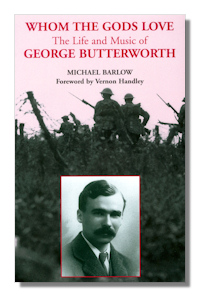
-
Whom The Gods Love: The Life And Music Of George Butterworth. Michael Barlow. Toccata Press. 1998, 2009. ISBN 0907689426 (hardcover), 0907689434 (paperback).
-
The career of the composer George Butterworth (1885-1916) was cruelly cut short by a sniper's bullet at the Somme. His name is kept alive by the popularity of his orchestral tone-poems, such as The Banks of Green Willow and A Shropshire Lad, and his songs. In this book, the first full-length study of Butterworth, Michael Barlow traces his brief life: from preparatory school through Eton and Oxford, a teaching post at Radley, study at the Royal College of Music, a period as a music critic for The Times – and his enlisting in August 1914 which, two years later, led to his tragic death from a sniper bullet at the Battle of the Somme. All of Butterworth's surviving compositions are discussed, and important chapters examine his Housman settings and his friendship with Vaughan Williams. Butterworth was also prominent in the folksong revival, and chronicled here for the first time are his extensive activities as a folksong and dance collector. The book also includes some of Butterworth's own writings on music. Read the Classical Net Review of this book.
-
Dietrich Buxtehude - Organist in Lubeck. Kerala J. Snyder. Wadsworth Publishing. 1993. ISBN 0028724550 (paperback).
-
















